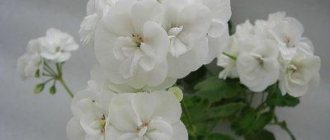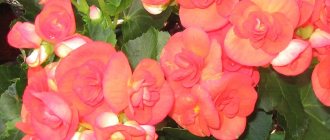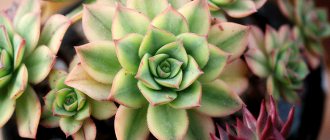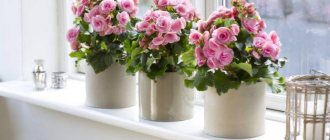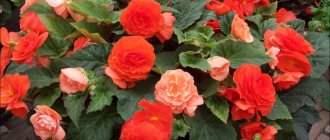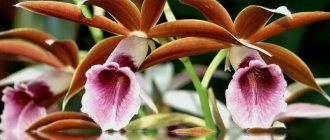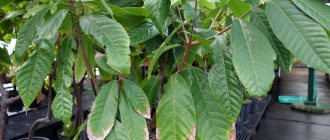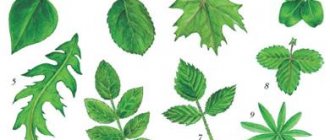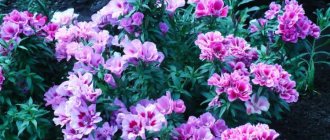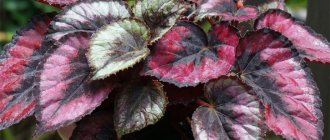Yandex.RTB RA-1479455-2
The most unpretentious begonias are root begonias. They do not need to have a rest period like tubers. However, the roots require care all year round. They are fed in winter, but less often than in summer; they are pruned in spring. Regardless of the type, all begonias grow well and delight with their decorative properties in high humidity in combination with unsalted soil. In this regard, there are nuances of watering: as the soil dries out, only in the tray you can avoid spraying the leaves. How to properly care for a flower so that it is as beautiful as in the photo of this article?
Origin of begonia and distinctive features
There are more than 1 thousand species of begonias in nature. The largest number of varieties is found in South America, followed by Asia (India, the Himalayas, Sri Lanka), and western Africa in third place. There is an assumption that Africa is the birthplace of begonias, from here they spread to Asia and America. In the wild, plants are found in humid subtropics and mountains.
Deciduous begonias
Yandex.RTB RA-1479455-7
The family was first described by the French botanist Charles Plumier. In 1683, under the leadership of the intendant of the French colonies, Michel Begon, he visited the islands of the Caribbean with an expedition. There the scientist discovered plants that were unknown at that time, gave them a description and named them after the organizer of the trip.
The begonias known today differ greatly from each other in size, shape, coloring of leaves and flowers. Some are perennial, others are annual. There are herbaceous and shrubby begonias, with creeping or thickened rhizomes. But there is also something in common that unites these plants into one family.
Characteristics of begonias:
- All types of begonias have an asymmetrical, oblique leaf;
- flowers are monoecious;
- perianths - brightly colored, unequal;
- the fruit with seeds looks like a capsule;
- all begonias grow in approximately the same natural conditions: diffused sunlight, high humidity, temperature +13... +22 °C.
Video: the wealth of types and colors of a flower
Tuberous begonia has gained the greatest popularity among gardeners. In beauty and abundance of flowers, begonias are second only to roses. The plant has a fairly long flowering interval: in open ground it lasts more than four months (from June to September), at home it can last up to six months or more. The plant does not like windy areas and direct sunlight.
No worse than roses
Yandex.RTB RA-1479455-3
The size of begonia flowers is very diverse: there are varieties with flowers up to 20-25 cm in diameter, however, most have smaller flowers, which compensate for this deficiency with a large number of flowers in inflorescences.
A variety with a large number of flowers in inflorescences
Yandex.RTB RA-1479455-8
The shape of the flower is also very diverse. A separate group includes ampelous begonias, which have a characteristic inflorescence shape and long branching shoots. There are also ever-flowering begonias, which are unique flowering record holders - it lasts up to 8 months for these plants.
Ampel beauty
The main difference between club begonia is the presence of a large rhizome, from which fairly thick stems with heart-shaped leaves grow. The stems are covered with fluffy petals.
Tuberous
Special begonias with bright blooms
It is no coincidence that the beautifully flowering species of begonias have become the most popular varieties of these amazing plants and have long eclipsed their deciduous and tuberous competitors. The division of indoor begonias into two groups, which are considered almost radically different, is not accidental and is completely justified. And although decorative deciduous begonias are also worth a closer look, and they are not as simple as they might seem, flowering begonias are still the absolute favorites of the Begonia genus in indoor format.
Begonias with beautiful flowering are famous for their simple or varying degrees of double flowers collected 1-2 in loose or denser corymbs, the shape of which is often compared to a head of cabbage. True, with the current variety of flowering begonias, you can also find flowers similar in shape to a rose, peony, star-shaped, anemone-shaped, carnation-shaped or other original flowers. Flowering begonias are limited in height to 20-50 cm, developing in the form of a compact and lush bush or hanging plant with hanging shoots (in hanging begonias, the flowers are collected in spectacular drooping clusters).
The leaves of begonias do not in any way resemble the variegated decorative deciduous varieties, but upon closer examination their similarity is obvious. Like all begonias, flowering begonias have asymmetrical leaves, most often heart-shaped, with a jagged edge. Their color ranges from dark to fairly bright medium green and light green, can be grassy or emerald, and recently varieties with purple leaves have become increasingly popular.
Features of early planting
Begonia is quite easy to breed, but there are a number of rules, failure to comply with which can lead to the death of the plant. One of them is the conditions under which the tubers are kept.
Even short-term hypothermia below +5°C can cause the top of the tuber to die, so its transportation and storage must take this circumstance into account.
The begonia tuber has a pronounced asymmetry: one of its sides is convex, the other is concave. Planting in the ground is allowed only with the convex side.
Preliminary germination of tubers should be carried out from February to the end of April. In this case, it is best to plant the tubers in separate small pots filled with peat substrate; Before planting, it is recommended to slightly moisten the peat. Having soil so rich in nutrients, the begonia will quickly develop and begin to form healthy leaves.
Planting should be done at room temperature. Immediately after this, the tuber should be watered moderately. Stagnation of water during further cultivation should not be allowed, however, the soil should not be allowed to dry out.
Tuber planted in peat substrate
Begonia x tuberhybrida pendula
Ampelous begonia Begonia x tuberhybrida pendula Illumination Apricot photo
So far we have talked about begonias that decorate window sills, flower stands, shelving, in general, our house, the inside of our apartment. However, in the spring-summer period, you really want to decorate it outside. The ampelous begonia with its drooping shoots, which cascade down and are decorated with many flowers, is perfect for this. The colors will also please you. This is white, yellow, pink, red, orange in its pure form, or more often a combination of them. Flowers can be simple or double, small, medium or large.
Let's consider several varieties of this species:
Christie - a fairly branched bush with large white flowers, hanging shoots, up to 40 cm;
Gale is a spreading begonia with large (up to 3 cm) semi-double flowers of a pale pink tone, stems about 30 cm long, green foliage;
Kati is a spreading begonia, insufficiently strong shoots grow up to 30 cm, blooms with large yellow flowers;
Roxana is a neat, dense bush with hanging shoots reaching 40 cm in length, orange flowers up to 4 cm in diameter;
Chanson is an excellent begonia with double flowers. Flowers up to 8 cm in diameter come in white, pink, red, and carmine shades.
Begonia transplant
As soon as the begonia sprouts reach a height of 5-6 cm, the plant must be transplanted into a larger pot. The minimum diameter of a pot for begonia at home should be at least 25 cm. Begonia tolerates replanting well, so at this stage there should not be any special problems.
A larger pot will allow the plant to begin its growing season in full: during the second month, the begonia will produce a large number of new leaves, and the first ovaries of flower buds will appear. Further transplants should be made in two cases: either when the root system of the begonia grows too much, or if it is necessary to plant the plant in open ground. This should be done as soon as weather conditions allow (temperature 15-20 °C).
Plants in need of replanting
The procedure for replanting a plant with a formed root system is somewhat more complicated: the flower must be completely removed from the pot and the roots must be cleared of soil. After this, they are treated with a solution of potassium permanganate by immersing them in a weak (0.1 g per 1 liter of water) solution. The residence time in the solution is no more than half an hour.
After disinfection of the plant, rotten and dried roots are cut off, and the cut areas are treated with charcoal powder. At the bottom of the pot you need to put drainage made of small crushed stone or large eggshells. The first two weeks after transplantation, the plant must be kept in the shade and provided with abundant watering.
Begonia transplant process
Features of transplanting into open ground
The place where begonias are planted must meet certain requirements: it must be an area protected from winds and direct sunlight. The ideal option is a semi-shaded area on the north side of the garden.
The planting rule is very simple - it is necessary to place begonia bushes at a distance of at least 30 cm from each other. Since the plant is decorative, it can be used for planting entire flower beds. The height of begonia reaches 35 cm, that is, this plant occupies a mid-level niche in flower beds.
After planting, it is recommended to mulch the soil with sawdust or small light stones (for example, expanded clay). Mulching helps the soil retain moisture longer and relieves the owner of the need to loosen the soil.
Flowerbed with perimeter of begonias
Keeping begonias at home
- Decorative leaf varieties of begonias feel great on northern windows.
- For potted crops, the easiest way is to buy ready-made seedlings.
- You can plant up to 3 rooted cuttings in one pot, so you will get a lush, beautiful bush.
- For begonias on the windowsill, you can use ready-made peat soil containing humus and perlite (sand) with a pH of 5.0-6.5, expanded clay drainage and complex mineral fertilizers in powder form that do not contain chlorine. This way you will protect the plant from burns.
- To make the foliage thicker, feed the begonia with organic or nitrogen-containing fertilizer.
- Having dug up the begonia in the fall, transplanted it into a pot on the windowsill, and with additional lighting, you will extend its flowering period until winter.
- Begonias of the Elatior group and Begonia hiemalis are capable of producing flowers all year round. They are unusually decorative; against the backdrop of lush foliage, clusters of double flowers, reminiscent of roses, look impressive. The colors of the flowers are varied - pink, cream, red, orange, yellow, salmon. They will do well if you place them in a warm, well-lit area. They will need a nutritious substrate; it is better to fertilize them with dry mineral fertilizers. Air humidity should be increased, so sometimes humidify the air (but not the velvety leaves) with a spray bottle, or place containers of water nearby.
- Place pots with home begonia so that its foliage does not come into contact with neighboring plants, ventilate the room, avoiding drafts.
If you decide to decorate your balcony with boxes of begonias, then it is better not to hang them on the south side - begonias do not tolerate temperatures above +25 degrees. But if all your balconies face south, then you will have to build a tray with wet pebbles and regularly moisten the substrate in order to cool the begonias. And this is quite a troublesome matter.
Lighting for begonias
Begonia prefers to grow in shaded areas or in areas where there is indirect sunlight. Contact with direct rays of the sun is unacceptable.
Begonia also does not tolerate changes in light: if the germination of the tuber and the beginning of the plant's growing season took place under the same lighting conditions, then when they change, the plant may begin to wither. In the house, the optimal location for the flower will be all well-lit window sills, except the southern one.
On the north side of the house in a warm climate
On southern window sills, if specialized shading or light diffusion measures are not applied, burns may appear on the leaves.
On a shaded windowsill
Story
Have you ever wondered where the tuberose flower grows? A photo of this plant will allow you to better imagine its decorative qualities. It is most often found in Mexico and the island of Trinidad. The southern territory is the first to be home to tuberose. Here the flower feels best in open ground conditions. Ever since Christopher Columbus discovered America, polyantes (the second name for tuberose) began to be actively exported to other continents. This plant tolerates cold well, as a result of which it can take root even in Asian countries. Tuberose appeared in Europe in 1632, when it was brought here straight from India.
Throughout the history of its existence on new continents, the plant has had two peaks of popularity. The first occurred during the Renaissance, and the second occurred at the end of the 19th century. Today, tuberose is regaining its popularity. However, in the harsh climate of our country, the flower will not be able to grow in open ground all year round. The plant has good endurance, but at the same time it is very capricious to care for. Only if you follow all the rules of planting, watering, disease prevention, and so on, will you be able to enjoy the wonderful aroma of this wonderful plant.
Plant care
Begonia feels good at temperatures from 18 °C to 22 °C. Seedlings require higher temperatures - from 20 ° C to 25 ° C. The soil should be neutral or acidic.
The temperature in the room with indoor begonias should not fall below +18 ° C, and the soil should not be alkaline.
Before transplanting into stationary pots, begonia seedlings require fertilizing once every two weeks with complex fertilizers. You can prepare them yourself from a mixture of nitrogen and potassium fertilizers, but it is better to purchase special fertilizers for violets and begonias, sold at any flower shop.
An adult plant is fertilized twice:
- nitrogenous fertilizers during the active growing season
- a mixture of phosphorus and potassium fertilizers before flowering
It is best to apply fertilizers in the evening, and two hours before applying them, the soil should be slightly moistened. After applying fertilizers, the plant is also lightly watered.
After flowering ends (as a rule, this occurs in late autumn), indoor begonias need light feeding with potassium fertilizers.
During flowering, the plant requires supports for the stems on which the flowers are located. This is due to the large number of flowers in the inflorescences or the relatively large mass of the flower compared to the stem.
With the onset of cold weather, garden begonias should dig up the tubers, clean and wash them, and then dry them for about a week in a cool, shaded room. Before drying, it is necessary to cut the stem no less than 3 cm from the tuber. After which the tubers are stored until February at temperatures of at least +5 °C. Once a month, the substrate on which stored begonias lie must be moistened.
Storing the tuber for storage
News:
Article date: 11/04/2007Family: Begoniaceae.
Homeland: is a complex hybrid.
Flowering: abundant, from summer to late autumn.
Growth: fast.
Light: depending on the variety (some varieties are more tolerant of bright summer sun than others). In indoor conditions, bright, diffused light is better.
Temperature: for normal flowering, depending on the variety, usually at least 10°C.
Watering: regular in summer, without drying out. During the dormant period, the substrate with wintering tubers is occasionally moistened.
Humidity: preferably high. For plants planted in containers, spraying is recommended.
Feeding: in order for begonias to develop foliage, after planting, they need to be fed two or three times with an interval of seven days with potassium nitrate, and then with a complete complex fertilizer with a low nitrogen content.
Pruning: fast-growing hanging begonias are pinched to form side shoots.
Dormant period: winter. It is advisable to store tubers in sand or peat at temperatures around 12°C. The rest period lasts about 3-3.5 months. To avoid drying out of the tubers, occasionally the substrate is carefully moistened.
Transplantation: annually at the end of the dormant period.
Reproduction: tubers, cuttings, seeds (less often).
Tuberous begonia (Begonia x tuberhybrida Voss). A herbaceous plant with a thick underground tuber-rhizome, succulent translucent stems, height from 20 to 80 cm. The leaves are alternately arranged, heart-shaped, asymmetrical. Flowers, depending on the variety, are simple, semi-double, double. Colors range from white to dark red, yellow, orange, except shades of blue, cyan, violet. The flowers are heterosexual, monoecious, that is, there are male and female flowers on the same plant. The shape of the flowers is single, semi-double and double. With additional pollination, tuberous begonia produces seeds well, which contain from 80 to 120 thousand in 1 g. Flowering occurs from May to November. In winter, begonia loses its leaves and enters a dormant period.
The name B. x tuberbybrida was proposed by A. Voz, since there was a large group of hybrids, as well as mutations from them, united by the presence of a perennial tuber. According to various sources, from six to nine species took part in the crossings, but the Bolivian begonia (B. bolimensis) is considered the main one. The first hybrid varieties went on sale in England in 1869 and were grown in greenhouses as beautiful flowering plants for rooms. The Belgian Louis Van Houtte was the first to cultivate begonia in open ground. Thanks to his work, begonia tubers began to be grown almost like tulip bulbs, and the city of Gand became the world center for tuberous begonia. In the 90s of the last century, about 50 million tubers were produced there per year. The selection of tuberous begonia proceeded very quickly, since the hybrids produced a lot of seeds, and the original species were distinguished by great diversity in flower shape and color. Already in 1874, V. Lemoine introduced gardeners to terry begonias. To this we can add that by the end of the 19th century there were about 200 names of forms and varieties. In a relatively short period of time, by 1900, hybrids with all the characteristic colors and double flowers went on sale. Further selection led to the creation of garden groups with flowers of various sizes: giant (gigantea) - up to 20 cm, large-flowered (grandiflora) - with flowers whose diameter is 8-10 cm, abundantly flowering (floribunda) - 8-12 cm and multi-flowered (multiflora ) - 5-7 cm in diameter. Nowadays, selection proceeds in two directions. The first of them is the creation of heterotic hybrids, more suitable for open ground. Most often they are grown annually from seeds. The second, more traditional, direction pays more attention to the variety of flowers in color and shape. Such varieties are most often sold as tubers, although heterotic hybrids can also be sold as tubers.
The varieties and hybrids of the gigantea group are distinguished by the greatest variety in the shape of flowers and petals. Double flowers resemble camellia, peony or anemone. The petals of large flowers can be heavily ruffled or gathered (form crispa), or cut or fringed (form fimbriata).
A special place is occupied by ampelous tuberous begonias (B. pendula flore pleno), which were obtained by crossing various forms of the multiflora group. They have semi-double and double graceful flowers on thin drooping pedicels. But their advantage is not only decorative - they tolerate the sun well, bloom early and abundantly. Therefore, they are readily used in flower beds.
Tuberous begonia (Begonia x tuberhybrida Voss) belongs to the genus Begonia (Begonia L.). The genus contains, according to various sources, from 400 to 1000 wild species of plants of the begoniaceae family, growing in tropical and subtropical regions of America, Africa and Asia. Begonia was first introduced to Santo Domingo in 1690 by botanist Charles Plumiero.
The name of the genus Begonia (Begonia L.) comes from the name of the great lover and collector of the plant, M. Begon, who lived in Santo Domingo in the 17th century; C. Lineus, who described it, named begonia in his honor. In Russia, begonia has been known for a long time, and after the French fled from Moscow in 1812, it received an interesting Russian name - “Napoleon's ear”, since the outline and reddish color of the underside of the leaf of some types of begonia really looks like a large frostbitten ear.
Kinds:
Camelia Flowered Double Mixed. Multiflora group . Plant height is 25-30 cm, flowers are medium-sized, densely double, beautifully shaped. A mixture of varieties of the following colors: orange, carmine, red, bright yellow, white, pink in various shades. Tubers on sale.
Camelia Flowered F1 Pavilion. Grandiflora group . Height 25 - 30 cm, flowers are large, up to 15 cm in diameter, similar to camellia flowers. They are resistant to cool and hot weather. The series includes hybrids: Orange - orange flowers, Rose - pink, White - white, Yellow - yellow.
Clips F1 . Multiflora group . Height 25-30 cm, strongly branching bushes up to 30-40 cm wide, flowering early and abundantly, flowers are medium-sized, about 6 cm in diameter, densely double. The series includes hybrids: Scharlach - red flowers, Orange - orange, Gold Orange - golden orange, Rosa - pink, Gelb - yellow, Weifi - white and a mixture of colors.
Crispa . Multiflora group . The plants are drooping, the flowers are strongly corrugated, double, single-colored or white with a red edge.
Fortune F1 . floribunda group . Height 25-30 cm, early and abundant flowering, double flowers, 8-9 cm in diameter, resistant to low air and soil humidity. The series includes 12 hybrids with different colors and a mixture.
Fringed Double Mixed . Height 25-30 cm, flowers double, fringed (type fimbriata ). The mixture includes varieties with white, yellow and red flowers. Seeds and tubers available for sale.
Illumination F1 Series . Girlandebegonie Illumination , Garland Illumination . Group of ampelous begonias. Plants with thin, fast growing shoots. The leaves are medium-sized, the flowers are small, about 5 cm in diameter, double, graceful in shape. The series includes hybrids: Lachsrosa - salmon-pink flowers, Apricot - yellow-apricot flowers, Orange - orange flowers, Rosa - deep pink flowers and Weifi - white flowers.
Memory F1 Series. Height 25-30 cm, upright growing powerful compact plants forming large tubers, flowering abundantly and long-lasting, flowers densely double, beautifully shaped. The series includes seven hybrids and a mixture: Gelb - yellow flowers, Golden Orange - yellow-orange, Feuerrot - bright red, Lachsrosa - salmon pink, Rosa - pink, Scharlach - dark red and Weib - white.
Musical F1 Series . Multiflora group . Plants bloom early and abundantly, with a vigorously growing bush and small leaves. The flowers are small, about 6 cm in diameter, double, on slightly drooping pedicels. The series includes hybrids: Scharlach - red flowers, Orange - orange and a mixture. Plants are more suitable for pots, balconies and hanging baskets.
Nonstop F1 . floribunda group . The most common series of hybrids. Height 20-30 cm, very compact plants with beautiful foliage, flowering abundantly and long-lasting, flowers with a diameter of 9-12 cm. Plants are quite resistant to low air and soil humidity. The series includes 12 hybrids of different colors and a mixture.
Ornament F1 Series . Height 20-25 cm, plants are compact, flowering profusely, leaves are large with a red-brown tint, flowers are 8-10 cm in diameter, densely double. The series includes four hybrids and a mixture: Gelb - dark yellow flowers, Hellrosa - pink, Scharlach - dark red and Orange - orange.
Panorama F1 Series . Height 25-30 cm, cascading plants, well branched, fast growing, leaves dark green and dark brown, medium-sized, flowers about 5 cm in diameter, double. The series includes five hybrids and a mixture: Apricot - exquisite yellow-orange flowers, emerald green leaves, Gelb - yellow, Rosa - dark pink, Scharlach - bright red flowers, dark brown leaves and Weifi - white.
Pin-Up F1 Series . Height 25-30 cm, plants are compact, weather-resistant, flowers are not double, very large, up to 15 cm in diameter, with a slightly corrugated edge, two-colored. Pin-Up F1 Flame . The flowers are golden-yellow with a red-orange border, the leaves are dark green. Seeds and tubers available for sale. Pin-Up F1 Rosa - pure white flowers with a dark pink border. Seeds and tubers available for sale.
Renaissance . A group of varieties distinguished by their huge flowers, early flowering and powerful stems. The group includes varieties: Expresso Picotee Blend. A mixture of four colors and shades: white with a pink edge, light yellow, pale salmon and pink. The flowers are slightly corrugated, double. Tubers on sale. Trumpet . Flowers with a diameter of 15-18 cm, double, on powerful stems. The color is monochromatic: orange, dark pink, yellow, red and white, as well as two-color. Popular varieties: Cardinal Giant - white flowers with a dark red edge, Strawberry Ice Giant - white with a pink edge, Amber Giant - yellow with a red edge. Tubers on sale.
Sensation . A group of ampelous dwarf begonias forming a cascade. The plants are very resistant to bad weather, bloom abundantly, double flowers, about 10-12 cm in diameter. Good in hanging baskets with pelargoniums and balsams. The group includes varieties with a single color: Red - red flowers, Yellow - yellow, Orange - orange, Pink - pink, White - white, as well as two-colored: Fireside - yellow-cream flowers with a pink edge, Sunlight - white with dark red edge and strokes, Blushing - light cream with a pink edge, Sunset - bright yellow with a hot pink edge.
| B. x tuberhybrida | B. x tuberhybrida Double Camelia Pink | B. x tuberhybrida |
Plant care:
Dependence on growing conditions
The relationship of tuberous begonias to light varies. Plants with small flowers develop well in sunny places, while large-flowered plants grow better in partial shade. The same is true for ampelous forms: the smaller the flower, the better the plant feels in the sun. Both tall begonias with large flowers and hanging begonias should be planted in places protected from the winds so that the fragile succulent shoots do not break.
Due to its complex hybrid origin, the attitude of different groups of tuberous begonia to the temperature regime is different. If in general this plant can be considered more heat-loving than ever-flowering begonia (B. semperflorens) , then the most demanding varieties of large-flowered begonias , and relatively cold-resistant are heterotic hybrids floribunda group , which bloom well at a temperature of about 10°C, while In large-flowered begonias, at this temperature, flowering weakens, and the buds may fall off. None of the varieties of tuberous begonia can tolerate even light frosts. Plants especially suffer from cold winds; the edges of their leaves may turn black. But hot, dry weather is not conducive to good growth and flowering. In dry, heated soil, the roots stop growing and may die completely, flowers, leaves and buds fall off, and an almost bare stem remains. Begonia reacts poorly to low air humidity.
All begonias are moisture-loving plants; with a lack of moisture, their leaves become dull and their buds fall off. But excess moisture causes various rots to appear.
In places exposed to the wind, plants suffer more, especially dark-leaved varieties and hybrids. It can be assumed that only heterotic hybrids with small flowers can grow in open flower beds.
The soil
Tuberous begonias are demanding on soils and grow well in loose and nutritious soils with a neutral reaction. Heterotic hybrids are less capricious and can grow on denser soil. For adult plants, the best mixture is 3 parts of deciduous soil, 1 part each of peat and sand. It is advisable to add 1 part of rotted cow manure to this mixture.
Landing
It is better to plant tuberous begonia in open ground in early June. On closed loggias it is possible earlier - in mid-May. If the temperature drops, it must be covered. Purchased seedlings, including flowering ones, can be kept at home in a bright window, but not in bright sun, providing it with sufficient humidity.
When planting, you need to very carefully remove the seedlings from the pot, especially if they are overgrown, since the succulent stem can easily break. Seedlings from seeds are buried 1-1.5 cm lower than they were in the pot. Tall seedlings and plants obtained from tubers should be planted 2-2.5 cm deeper to provide stability. It is recommended to place slowly dissolving fertilizers containing potassium and phosphorus in the hole and pour them well. It is better to plant tall varieties of begonias in flower beds at a distance of 30-35 cm from each other, compact hybrids - at 25-30 cm. They are planted in containers, especially ampelous forms, at 10-15 cm.
Care
The main thing in caring for tuberous begonia is proper watering. To maintain flowering in hot, dry weather, you need to water early in the morning, but not with cold water. When watering during the day, burns appear on the leaves, and subsequently they fall off. If you water overheated soil with cold water, the roots will die.
To increase the resistance of plants when heat sets in, they need to be sprinkled with growth substances (humate, epin, zircon). It is advisable not only to water begonias in containers, but also to spray them with warm water in the morning and evening.
In order for begonias to develop foliage, after planting they need to be fed two or three times with an interval of seven days with potassium nitrate, and then with a complete complex fertilizer with a low nitrogen content. Excess nitrogen causes plants to stretch out and, in damp weather, contributes to their rotting.
Until the plants grow, it is necessary to keep the soil loose and remove weeds.
Tall begonias with large flowers should be tied to small stakes to prevent them from breaking in the wind or during heavy rains.
In containers, fast-growing ampelous begonias are pinched to form side shoots. In addition, to prevent the shoots from rotting when they become very thick, it is recommended to either distribute them throughout the container or remove excess and weak ones.
Overwintering, propagation by tubers
At the end of August, before frost, you need to decide what to do with the tuberous begonia next: leave it at home for further flowering or dig it up to obtain tubers. In the first case, the plants are transplanted into a pot, preserving the root system if possible. In the second, without cutting the stem and leaves, they dig it up with the largest possible lump and place it to dry in a well-ventilated, shady place, protected from rain.
With a short autumn day, the leaves gradually dry out, and nutrients from them enter the tuber. Thus, a large tuber is formed within one month. In industrial cultivation, in addition, at the moment of mass flowering, flowers are removed from plants.
At the end of the growing season, begonia should be covered from frost at night with paper, gauze or plastic wrap. After flowering, begonia goes into a dormant state. During this period, watering is reduced and the plants are moved to a dark place. After about 1–1.5 months, the above-ground part of the begonia dies, after which the tuber is left in the ground for another 2-3 weeks. After this, the tubers are dug up and placed in a box with sand or peat. The substrate in which the tubers are stored is slightly moistened from time to time so that the tubers do not dry out. The box with tubers is kept in a cool room with a temperature of 12–14°C. 2–3 months before planting in balcony boxes, the tubers are removed from the sand and planted in pots with soil. Tubers have an upper and lower part. On the upper part, which is flatter or concave, there are buds that look like bumps and bumps. The lower part is smoother, slightly convex, and roots will form on it after planting. Tubers germinate well at a temperature of 22–24°C and regular watering. Old tubers can be cut into 2-4 parts, so that each piece has 3-4 buds. It is advisable to sprinkle the cut areas with charcoal powder.
When purchasing tubers, you need to pay attention to their size and type. The diameter should be at least 3 cm; for ampelous small-flowered begonias it is slightly smaller. Well-cleaned tubers should be smooth and dense at the top.
Seed propagation
Begonia seeds are very small. To obtain them, flowers are artificially pollinated, for which pollen from male flowers is transferred with a brush to the pistils of female flowers. To get flowering begonias in the summer, the seeds need to be sown in December-January in leafy soil, and should not be sprinkled with soil. The container with the planted seeds is tightly covered with glass to prevent the top layer of the substrate from drying out. The optimal temperature for seed germination is 22-25°C. The earth is periodically moistened. The glass needs to be opened slightly from time to time to prevent excess moisture and mold. Shoots appear in 14-16 days. Dive in the state of two cotyledon leaves into deciduous soil at a distance of 2 x 2 cm at a temperature of 20-22°C, after which they are covered with glass for 2-3 days. When the leaves are closed, a second pick is made at a distance of 4 x 5 cm, and then a third - after 6 x 7 cm.
The soil mixture for the second and third pickings consists of 2 parts of deciduous soil, 1 part of turf soil and peat, and 0.5 parts of sand (mixture pH 6-6.5). After the third pick, when the leaves close, the begonia is planted in 11-13-centimeter pots with a lump of earth, adding 1 part of deciduous soil, a little bone meal and ground dry cow manure to the soil mixture. After planting, water abundantly and lightly shade.
Begonias often turn out to be tall and unstable. To avoid this, during the formation of 5 leaves, plants are sprayed with a growth regulator (retardant) - chlorocholine chloride (0.5% solution, 20-30 ml per plant), which inhibits growth. Under its influence, the plants have a compact, low bush with numerous flowers.
Young plants are planted in balcony boxes after the spring frosts have ended, at a distance of 20 cm from each other.
When propagated by seed, plants bloom on the 135–150th day after planting.
Propagation by cuttings
When propagating by cuttings from well-developed plants, cut off the apical part of the stem 6–10 cm long with several leaves. The lower leaves on the cut cuttings are removed, and the cut site is sprinkled with charcoal powder, after which the cuttings are planted in sand, watered and covered with a glass jar. The jar needs to be lifted from time to time to avoid excessive moisture. The cuttings take root in about 2–3 weeks. After this, it is transplanted into nutritious soil. The advantage of propagation by cuttings over seed propagation is that the plant obtained in this way retains all the characteristics of the mother plant.
Indoor culture of tuberous begonias
At home, tuberous begonia, purchased as seedlings in a pot, will bloom in the summer in a fairly bright window, but not in the sun. If the pot is placed in soil or peat and watered moderately, this will provide normal humidity for growth and flowering. If tuberous begonia is shaded too much or pots are placed on northern windows, it stretches out and loses its decorative effect.
Begonias bloom much better in boxes on a shady balcony or on the balcony floor. Plants in pots and boxes require regular feeding with complete complex fertilizers. In such conditions, begonias grown from tubers feel better and bloom more profusely.
Possible difficulties:
Powdery mildew and gray rot can occur both in open ground and indoors. Powdery mildew occurs in hot, humid conditions. Gray rot is more common in cold, damp weather. In both cases, it is necessary to remove diseased leaves and increase ventilation. In case of severe damage, plants should be sprayed with special preparations.
The plant stretches due to lack of light and nutrients, or because the container is too small.
When the earthen coma dries out or becomes waterlogged, it becomes affected by powdery mildew.
In cold and damp conditions, gray mold may appear - it is necessary to improve ventilation.
When affected by leaf rot, a coating and brown spots appear on the leaves (you need to remove the damaged parts and treat the plant with a fungicide solution).
If kept excessively damp and cold, root rot may appear, as well as leaf spotting when water gets on them.
Yellowing of leaves is observed with a lack of light;
Brown, papery leaf edges indicate dry air or direct sunlight hitting the plant.
When temperatures are too high and humidity is too low, plant leaves dry out and curl.
In low light (if the shoot stretches excessively), dry air (if the leaves are wrinkled), or excess moisture (leaves begin to droop), leaves may fall off.
If the air is too dry, lack of moisture or sudden temperature fluctuations, flower buds dry out.
If there is insufficient air humidity, the buds may fall off.
Damaged by: aphids, scale insects and false scale insects, thrips, whiteflies, nematodes.
Discuss the article and care on the forum
Section about Begoniaceae on the forum
How to propagate begonia from cuttings: leaves, shoots - a topic on the forum.
How to sow begonia seeds - topic on the forum
Photos of our begonias - section with photographs and reviews.
Tuberous begonia (Begonia x tuberhybrida) in the flower garden!
How to grow tuberous begonia in open ground - a topic on the forum
How to plant a tuberous begonia tuber - an article about planting begonia tubers
Share the link
Materials used in the article:
V. Vorontsov, D. Kudryavets Begonias in the house and in the garden. M. ZAO UFiton+F, 2004
Indoor floriculture / R. Milevskaya, Y. Vies. - Mn.: Book House, 2005. - 608 p., ill.
Stepura A.V. Home decorative floriculture. Modern encyclopedia: 5000 valuable advice from professionals. - Donetsk: LLC PKF "BAO", 2006. - 384 p.
https://home-and-garden.webshots.com/photo/1185874493047436449AptfxG
Features of watering
To maintain the plant in good condition, it must be properly watered. Begonia at home requires special attention. In the summer, drying out is not acceptable for a plant with massive stems and leaves.
In normal temperature ranges, begonias need to be watered once every 2-3 days, however, in hot weather, watering should be done every day. This is especially important during the flowering period.
The soil should be well moistened, however, there should be no stagnation of water. In this regard, pot drainage plays a significant role. It should reach about a quarter of its height. The best element for draining adult begonias is expanded clay.
Drainage system
It is best to water the plant with rain or settled water. Before watering, you need to make sure that the soil in the pot is almost completely dry.
Water should not get on the plant leaves or flowers. If this happens constantly, the leaves will begin to rot.
Some types of begonias can be sprayed to humidify the air. However, this should not be done for stems and leaves with a “velvety” texture and for any plants during flowering.
In what cases is a transplant required?
Every 2-3 years, any indoor plant must be replanted , because during this time the substrate is depleted, and the roots become cramped in the pot (you can read about how to replant a begonia and care for it after the procedure). There are also cases when an unscheduled transplant is required:
- it is recommended to replant begonia after purchase, since the soil in which it is sold is not suitable for its further growth;
- if the plant has outgrown the old pot and the roots are visible on the surface and in the drainage holes;
- if there is a suspicion of root rot, infection with fungus, mold or parasites;
- in the case when the previous transplant was carried out incorrectly and the plant withers;
- if the old pot is damaged.
Other options are also possible, for example, abuse of fertilizers, incorrectly selected soil, or propagation of begonia by dividing a bush (how to propagate rooted indoor begonia?). In any case, it is important to strictly follow the replanting rules and carefully consider the further care of the plant.
Begonia propagation
This process can be carried out in three ways:
- seeds
- cuttings
- dividing the tuber
The first method is almost never used due to its labor intensity, so begonia propagation at home is most often carried out by vegetative methods.
Propagation by cuttings
For this purpose, cuttings from stems or leaves are prepared; The optimal time for cutting cuttings is early May. It is best to use whole leaves as cuttings. The prepared cuttings are installed in a substrate of peat-sand mixture. Sometimes cuttings are germinated in water before being placed in the substrate.
It would be a good idea to treat the cut of the cutting with any rooting agent. Watering the cuttings should not be too frequent - approximately once every 7 days. More frequent watering leads to rotting of the cuttings.
After about a month, the cuttings take root and can be transplanted into a separate pot.
Stem cutting
Reproduction by tuber division
This is the main method of propagating begonias when caring for them at home. In this case, young tubers are used, which should be germinated for no more than 1 week before dividing (until the first shoots appear).
Division is done by cutting the tuber into pieces with a knife, so that each part of the tuber has a sprout and a root. The cut site is treated with charcoal or sulfur. After this, the tubers are placed in a substrate (preferably pure peat), but they are buried at about half the depth.
Separating begonia tubers
Ampel for home and office decoration
For home decor, small species of hanging begonia are used. They are planted in flowerpots or other hanging flowerpots so that the soft hanging stems with elegant tassels rise above the head and receive maximum light directly from above.
These representatives of the flora world bloom profusely. The root system is usually represented by a tuber , which increases in size throughout its life.
Problems with the plant
Begonia itself is a rather whimsical plant that requires careful care. Some simple begonia problems can be solved by paying close attention to the plant's appearance:
The presence of medium-sized brown spots on the leaves indicates that the plant has received burns and requires urgent transfer to a shaded area. If, after moving the plant into the shade, these spots do not go away, then the plant needs to be fed or the watering regime changed. Similar manifestations can occur with either excess or lack of nutrition or water.
Leaves that dry and subsequently fall off are a sign of excessive dry air around the begonia. This often happens at the end of winter, as warm air from heating radiators dries out moisture. In this case, humidifying the air with a spray will help. If the plant's stems rot, this indicates excessive watering. The watering regime should be reduced, while removing damaged parts of the plant.
The appearance of spots on the leaves
Pests
A plant weakened by improper care may lose its immunity. The consequence of this unpleasant process will be the appearance of pests. Powdery mildew can cause the greatest harm to begonias. This dangerous fungus can destroy the entire plant within a few days.
Fortunately, powdery mildew is vulnerable to even the weakest fungicides. Even such a simple folk remedy as a solution of garlic juice in warm water can easily cope with this begonia disease. To avoid re-infection of the plant, watering should be significantly reduced and the soil should be loosened regularly. It would also be a good idea to ventilate the room to get rid of stagnant air.
Another begonia pest is the common aphid. There is nothing left to do except remove the aphids manually. In this case, you can either collect aphids or treat the leaves with an alcohol solution. There are also special solutions to combat aphids, which are sold in garden stores.
Aphids on houseplants
Sometimes, with low air humidity, the plant can be attacked by spider mites. They fight it with a chamomile decoction or a simple solution of soap in water.
Growing seedlings
Tuberose can be easily grown both indoors and in open ground. The plant is a very heat-loving crop, which must be taken into account during planting and development. Most novice gardeners make basic mistakes when choosing a site or placing a flowerpot with a young plant, leaving the flower in the sun. It is most rational to plant tubers in soil that warms up to 10 °C. Too hot soil will damage the polyanthes root system.
The most effective method of growing tuberose indoors is the container method. If you follow exactly this method, you will achieve flowering of the tubers early enough and you will not have to deal with annual flower transplants from one flowerpot to another.
Bulbs are grown in the spring (May-April). Planting material is embedded into the soil no more than 1-3 centimeters. After just 3-4 weeks, it will be possible to observe the first shoots of the ornamental plant. The distance between adjacent specimens should be 15 centimeters. This will allow the young plant to take more space for normal development of the root system.
When choosing a site, you should pay special attention to the soil structure. The soil must be fertile and light. To achieve these goals, you can form a special sand cushion on the prepared area. This will also make the drainage layer better, since the plant does not like too much moisture at the roots.
We will also present several varieties of decorative flowering begonias:
Decorative flowering begonia Begonia Silk Flowers photo
Gold Dress is a branched bush, not very wide, with huge flowers up to 20 cm in diameter against a background of bright light foliage. The flowers are also yellow, double, pink-shaped;
Harlequin is a spreading bush with magnificent twelve-centimeter flowers. The yellow ruffled petals end in a red edge. Plant height 25 cm;
Camellia Flora is a compact, erect plant with pink, camellia-shaped flowers;
Decorative flowering begonia Premium Dark Scarlet photo
Dark Red - dark red, this is the color of double flowers, shaped like peony flowers, size - no more than 10 cm. A small (about 15 cm) semi-spreading bush has light green foliage;
Admi Jean Bard - a minimalist begonia with bright orange flowers, collected in inflorescences of 5 pieces, its leaves are small, green;
Begonia Crispa Marginata yellow-red photo
Crispa Marginata - a low bush (up to 15 cm) has large white or yellow flowers measuring 12 cm with a pink border, leaves are folded, green with purple edges;
Marmorata - a spreading bush with double flowers of bright red color with white streaks;
Terry begonia Diana Vinyard planting and care photo
Diana Vinyard - double begonia 20 cm high. Large white flowers 20 cm across have folded wavy petals;
Feuerflamme - crimson veins are visible on the green foliage, the flowers are semi-double, orange.
Benefits of growing begonias at home:
- air humidity increases, which has a beneficial effect on the skin;
- Begonia absorbs harmful substances from the air, thereby purifying the air. Used as an “antimicrobial” agent, it reduces the content of staphylococci in the air by 80%;
- the plant contains organic acids and tannins, which have antiallergic and antiseptic properties;
- It is useful to have begonia at home for smokers and people suffering from chronic bronchitis;
- the immunity of people living in the apartment increases;
- begonia eliminates the feeling of fatigue and restores performance;
- reduces nervous tension.
In folk medicine, begonia infusion is used to treat alcoholism . To do this, pour 2 tablespoons of crushed leaves with a tablespoon of olive oil, leave for 2 hours and take orally. Do this three times a day for a month.
To treat wounds and burns : pass washed and dried leaves through a meat grinder, squeeze out the juice, dilute with water 1:1 and make compresses. The juice can be stored in the refrigerator for no more than three days.
Plant energy
Begonia is a kind of energy filter: it absorbs all the energy in a row and releases only positive energy. Royal begonia will help speed up the pace of your life and give you determination. In general, begonia is a plant for businessmen and promotes successful trade deals.
Begonia is also useful for sentimental people; it makes them more balanced and not prone to depression. Begonia also helps to “gather thoughts together” and make the right decision. Grow this beautiful plant, good luck!

